Assessment of LCH Limited's SwapClear Service Appendix A: Activity in SwapClear
A.1 Global Activity
There were 121 direct clearing participants in the SwapClear service as at 30 September 2019, an increase of around 9 per cent over the assessment period.[15] Direct participants are domiciled in Australia, Canada, Europe, Hong Kong, Japan, New Zealand and the US.
The notional value of SwapClear trading activity grew by around 24 per cent in the assessment period (Graph 3). This was faster than in previous years and reflected a significant increase in OIS trade activity, which grew by around 40 per cent (Graph 4). In part, this growth has been attributed to activity arising in response to changing expectations regarding the likely path of monetary policy in a number of jurisdictions. Activity in forward rate agreements and interest rate swaps also grew, though by less than OIS activity. OIS, forward rate agreements and interest rate swaps account for 96 per cent of the notional value of trades registered. Basis swap activity was largely unchanged. SwapClear also clears other products including zero-coupon swaps, variable notional swaps, non-deliverable interest rate swaps and inflation swaps.

SwapClear clears over-the-counter (OTC) interest rate derivatives in 26 currencies. Around half of trades registered are denominated in USD and one quarter in EUR (Graph 5). The AUD is SwapClear's fourth most registered currency and accounts for around 5 per cent of trade registrations.

The stock of derivatives outstanding, as measured by notional value, increased as a result of ongoing new trade registrations exceeding maturities and trade compression activity (Graph 6).[16]
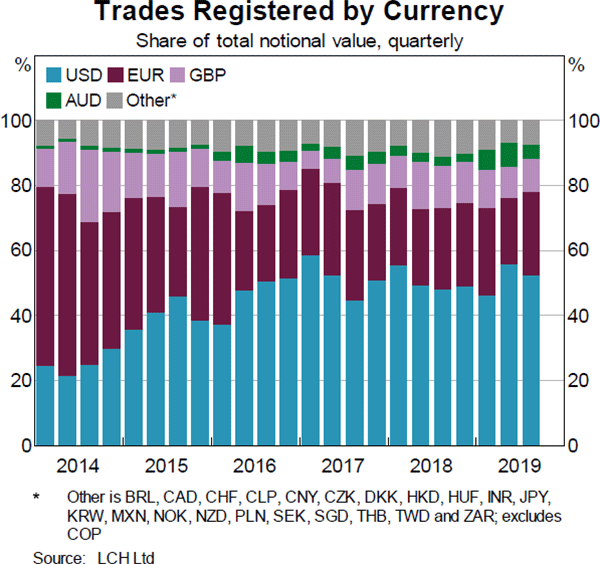
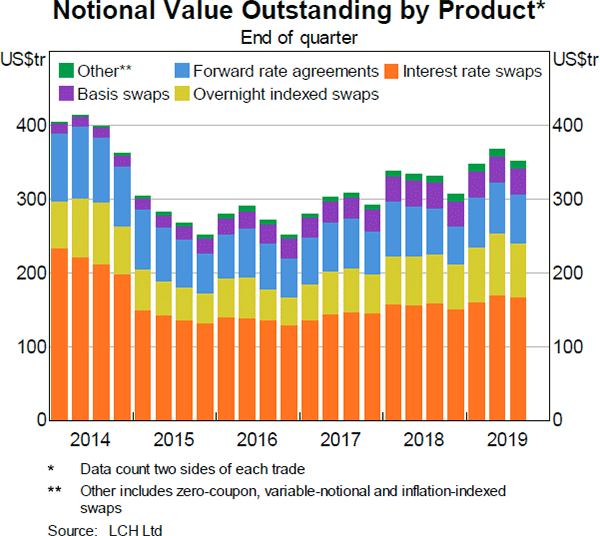
Initial margin, which is often viewed as a proxy for the level of risk the CCP manages, grew at a similar pace as notional value outstanding (Graph 7). Changes in initial margin requirements through time reflect changes in participants' portfolios, as well as changes to the parameters of the initial margin model. Initial margin add-ons are called to cover risks not captured in the base initial margin model, such as credit, liquidity, concentration and sovereign risks. Initial margin add-ons now comprise around 32 per cent of total initial margin posted by participants. After substantial growth between 2015 to 2017, the proportion of initial margin requirements met by clients has stabilised, fluctuating around 55 per cent since early 2017 (Graph 8).[17]

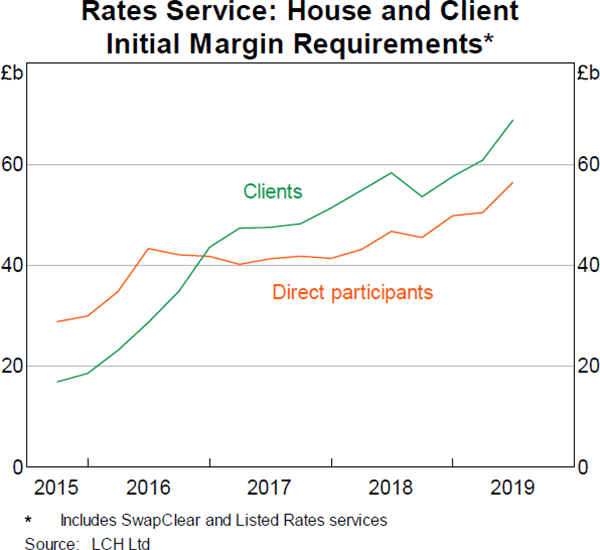
A.2 Australian Activity
A.2.1 Australian-domiciled direct clearing participants
SwapClear has six Australian-domiciled direct clearing participants – Australia and New Zealand Banking Group Ltd, Commonwealth Bank of Australia, Goldman Sachs Financial Markets Pty Ltd, Macquarie Bank Limited, National Australia Bank Limited, and Westpac Banking Corporation.
The total notional value of interest rate derivatives outstanding (in all currencies) cleared by Australian banks via SwapClear grew by 38 per cent in Australian dollar terms over the assessment period (Graph 9).
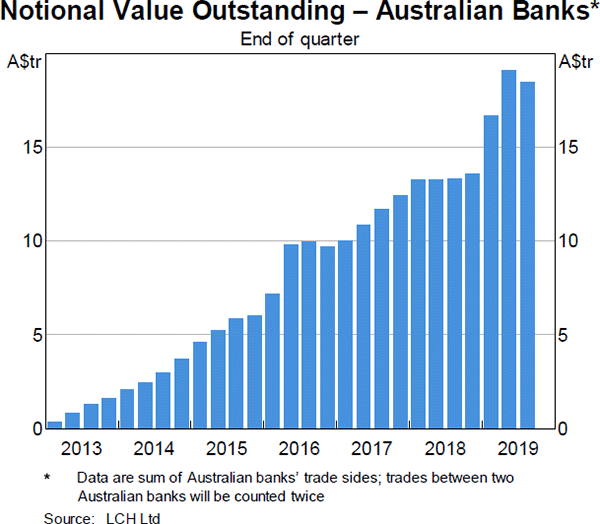
A.2.2 AUD-denominated OTC interest rate derivatives
Globally, an estimated 88 per cent of all centrally cleared AUD-denominated OTC interest rate derivatives registered during the assessment period were cleared via SwapClear. Total AUD activity at SwapClear increased substantially, driven by strong growth in AUD OIS, which increased by 250 per cent (Graph 10). The notional value of AUD OIS trades registered can fluctuate substantially, partly reflecting the role they play in providing a short-term hedge against overnight cash rate movements. OIS now accounts for around 40 per cent of the total notional value of AUD interest rate derivatives outstanding, though interest rate swaps contribute more to the risk cleared by participants because they have longer maturities. Basis, zero-coupon and variable notional swaps remain a small share of AUD activity.
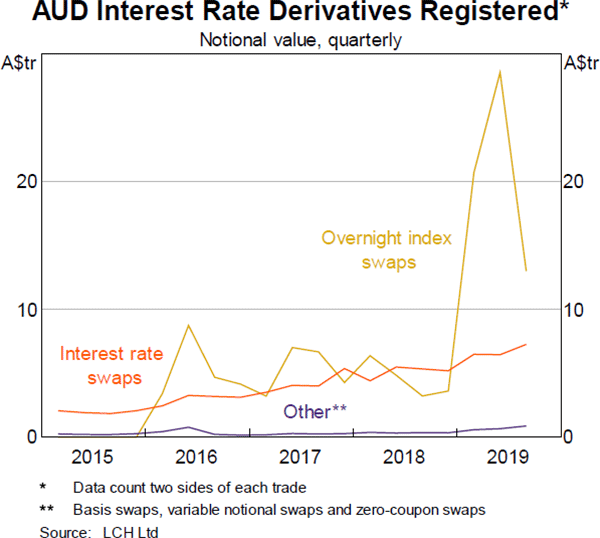
A.3 Operational Performance
LCH Ltd targets IT system availability for the SwapClear service equivalent to at least 99.7 per cent. In effect this means that system outages should last no more than 60 minutes in any one calendar month.[18] SwapClear met this target in 11 months of the assessment period; IT system availability averaged 99.9 per cent.
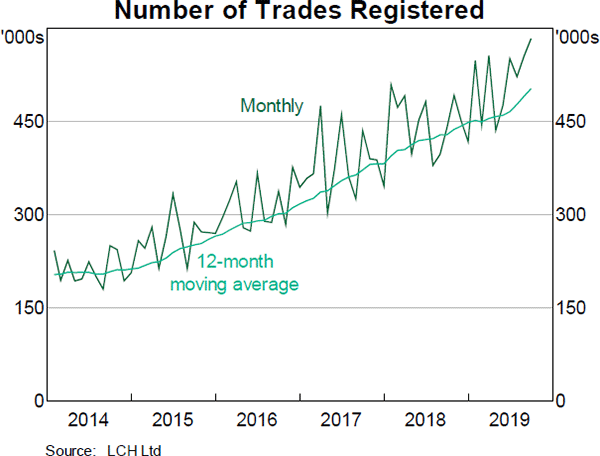
The average number of trades registered in SwapClear each month has increased by 17 per cent (Graph 11). LCH Ltd has met its target for maximum capacity utilisation of 50 per cent in each month in the assessment period for the SwapClear service. LCH Ltd deems its capacity utilisation target to be met if the service has the capacity to handle the greater of either (i) two times current daily peak throughput of trades registered over the previous two years, or (ii) the projected daily average throughput in 12 months' time.
Footnotes
Unless otherwise stated, all positions data reported in this Appendix are as at the end of the assessment period (30 September 2019) while all activity data and growth rates are reported over the 12 months to the end of the assessment period. [15]
Compression involves identifying offsetting trades in participants' portfolios and terminating them, while leaving those participants' market-facing exposures unchanged or within a predefined tolerance. [16]
For further information on client clearing, see Box A in the 2017/18 Assessment of LCH Limited's SwapClear Service. Available at <https://www.rba.gov.au/payments-and-infrastructure/financial-market-infrastructure/clearing-and-settlement-facilities/assessments/lch/2018/>. [17]
LCH Ltd weights outages to calculate service availability: a weight of one where there is full service outage; a weight of 0.5 or 0.25 for partial outages, depending on the incident; and a weight of zero for partial losses of resilience, such as when the service is still operating but an additional server used to share the load is unavailable. [18]